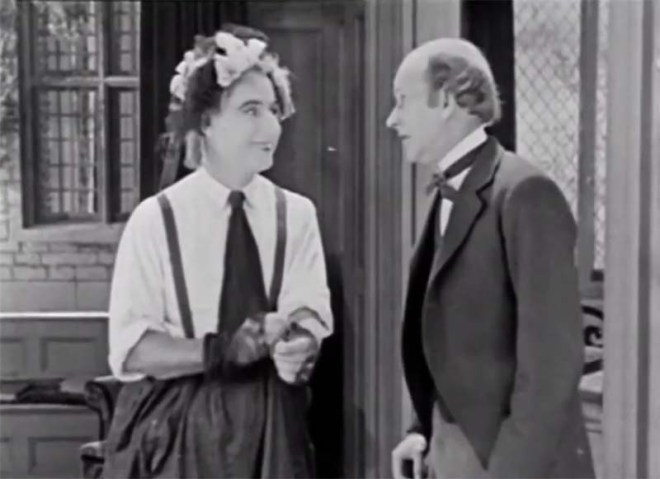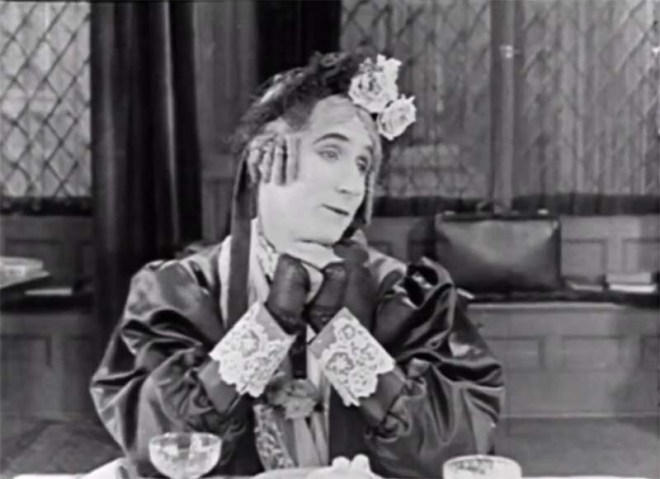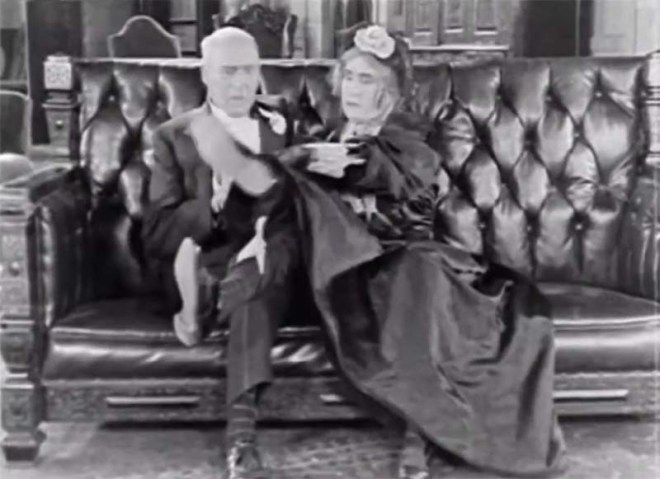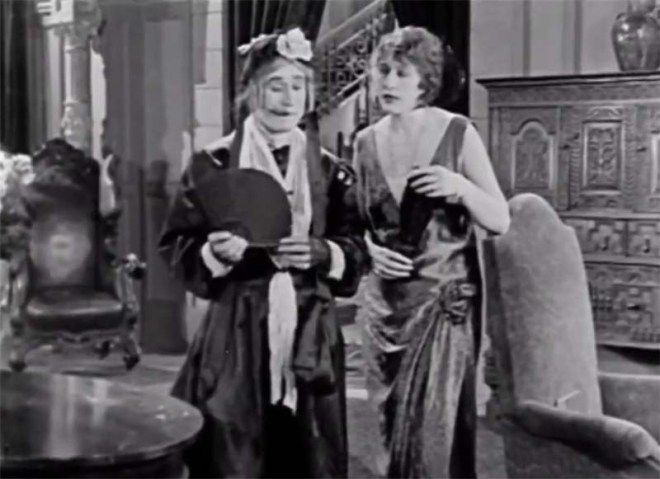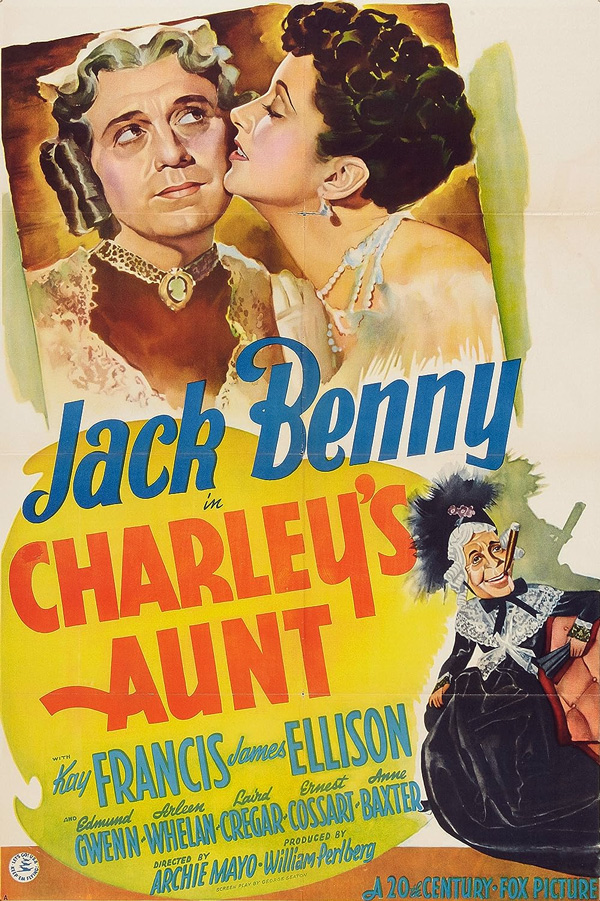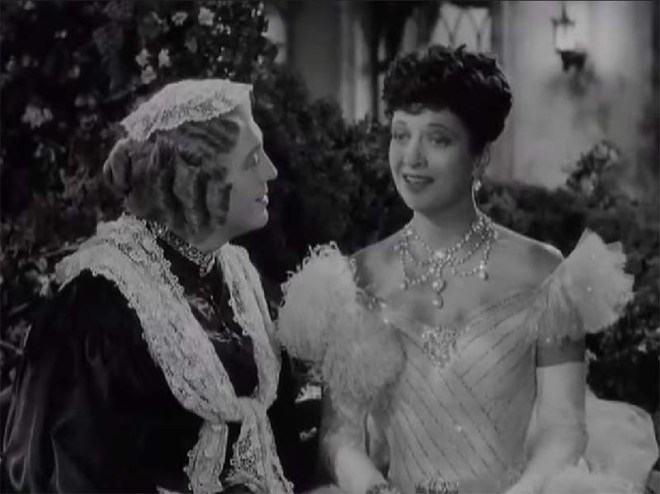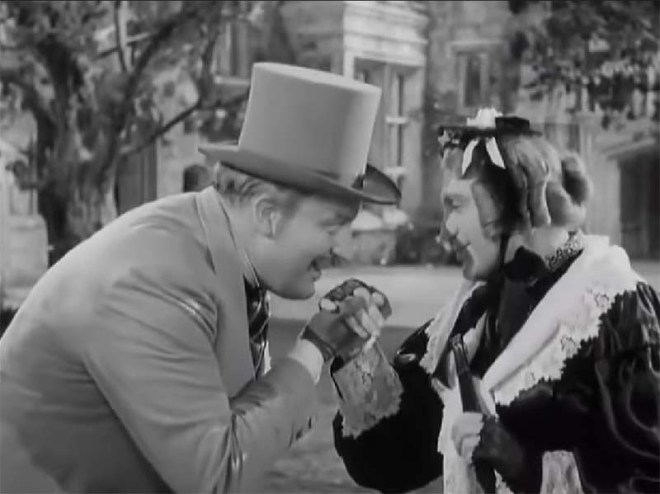When a pair of college chums concoct a scheme to propose to their girlfriends, they run into an unsurmountable obstacle when a widowed aunt from Brazil cannot make it in time to play chaperone. Fortunately, their pal has been rehearsing a role as a pantomime dame. I wonder if these two situations will collide?
Home Media Availability: Stream online.
Where the nuts are from!
How do you build a comedy career in the movies when your little brother is Charlie Chaplin? That was the question Sydney Chaplin faced. He had started out in the 1910s with a crepe mustache and met with some success in productions like A Submarine Pirate but nothing really captured the public fancy enough to send him to the top ranks of funnymen.
Charley’s Aunt was during an era of rebranding for Chaplin. Rather than pursuing slapstick, his 1920s films were more along the lines of the breezy comedies of Reginald Denny, Richard Dix and Douglas MacLean.
The film was based on the wildly popular 1892 stage production of the same name by Brandon Thomas. It had been a runaway international hit and no wonder. A naughty-but-nice farce was very much in line with tastes of the time and the idea of a young man posing as an elderly woman had endless potential for gags, both bawdy and innocent. The film’s Oxford setting and posh cast is similar to the kind of society comedy P.G. Wodehouse would specialize in decades later.
The film opens with Lord Fancourt Babberley (Sydney Chaplin), Babbs to his friends, courting Ela (Ethel Shannon) while her father (Alec B. Francis) loses his fortune at the roulette table. Babbs wants to help, first by trying to arrange a fortuitous win at the roulette table and later by faking a win with a lottery ticket. Ela doesn’t realize that Babbs is trying to funnel money back into the family coffers and assumes he is merely a wastrel tempting her father to gamble, so she dumps him and bans him from her home. She realizes too late what his real game was and hopes to reconcile.
None of this was in the original play, Babbs simply recounts a slightly different story of loving and losing Ela, but it is an understandable change. Stage plays by their nature had to limit the number of locations used and Charley’s Aunt takes place almost exclusively at a college dormitory. Offering a bit of variety in setting makes a film adaptation fresher, especially since this version of the play follows its source material pretty closely from here on.
We then switch to Oxford, where two students, Jack (David James) and Charley (James Harrison) hope to court Kitty (Priscilla Bonner) and Amy (Mary Akin) but their guardian, Spettigue (James E. Page), refuses to give his consent because he will lose his income if his wards marry. Jack and Charley hatch a plan to host the women with Charley’s rich aunt, Donna Lucia, when she arrives for a visit from Brazil. Meanwhile, Jack’s father (Phillips Smalley, Lois Weber’s husband and collaborator) has lost his fortune and hopes to court the wealthy Brazilian widow. Longsuffering manservant Brasset (Lucien Littlefield) observes all with dejected acceptance.
Unfortunately, Charley’s aunt is late and can’t make it to the lunch date that Jack and Charley have already arranged. It cannot be postponed because Spettigue is sending Amy and Kitty to Scotland to separate them from the boys. But then, wouldn’t you know it, Babbs shows up with the costume he means to wear in an amateur play. His character? An elderly lady. One might even say… an aunt-like figure…
At this point, I was losing hope. A basic element of a farce comedy is the formal structure of the plot. The plot devices are practically wheeled in on a dessert cart for the audience to inspect before they are deployed. With that in mind, Charley’s Aunt is perhaps a bit too deliberate in its presentation. We expect a bit of artifice but when Babbs announces that he will be playing a lady on stage, this isn’t Chekhov’s Gun, it’s Chekhov’s Arsenal.
For all that, Charley’s Aunt still manages to be confusing. It’s never exactly clear where Babbs got the money to pay Ela’s father and why he is totally broke afterward. The modern setting makes Kitty and Amy insisting on a chaperone seem anachronistic. Too many characters are introduced at once; we are expected to remember Kitty and Amy and Jack and Charley and Spettigue and Bressett and Sir Francis immediately, plus all the unimportant characters who filter through but we aren’t sure if we are supposed to remember them or not.
These issues may be rooted in the fact that audiences of 1925 would have been expected to be familiar with the characters and plot of Charley’s Aunt, so editing for clarity was not a priority. However, it’s rather irritating for a modern viewer.
Anyway, things were not looking promising for the picture but everything changed once Sydney Chaplin entered as, well, Charley’s Aunt.
He is, in a word, spectacular in the role. The physical comedy, the expressions on his face, his exasperation at the bizarre situation, his joy realizing that he can flirt with and kiss women with abandon, his gleeful manipulation of his two older male suitors, it’s all pitch perfect. Chaplin was, after all, a veteran of the music hall and drag-based humor was a staple. We are clearly in the hands of a professional.
(At forty, Chaplin is a bit too old for the part, age defying silent era photography notwithstanding, and Peter Milne heckled the evergreen cinematic staple of the middle-aged college boy all the way back in 1922: “Then there are the horrible directorial conventions regarding college life. A motion picture college is full of snobs, its dormitories are made up of rooms wall-papered with pennants and peopled with thirty-five year old actors in bulky sweaters.” Hold that thought.)
What follows is an unrelentingly mad series of events with Babbs seducing Spettigue, Sir Francis trying to get in on the action, the real Donna Lucia showing up with Ela in tow and deciding to have some fun of her own with the imposter, and, finally, Sir Francis realizing that he has a secret connection to this mysterious new lady.
It’s all chaos and I loved it very much. Obviously, all’s well that ends well, as is the case with most farces, but getting there is all the fun.
Sydney Chaplin’s career enjoyed a bump from productions like Charley’s Aunt. He’s still best known as Charlie Chaplin’s big brother but with pictures like this in his filmography, he is also a bit of a hidden gem in the ranks of silent comedy. He even returned to a skirt role in Oh What a Nurse! in 1926. The second Chaplin seemed to have arrived… but the story takes a dark turn.
While filming in England, Chaplin was accused of a violent sexual assault and subsequently launched a smear campaign against his accuser. (Be cautious with the link as even the safe-for-news description of the assault might be upsetting to some readers.) No formal charges were filed but there were also tax issues and Chaplin seemed to have given up on stardom in his own right in the aftermath.
Nothing like film history to jack-knife around and add a sinister undertone to certain pictures, eh? (See also: Gig Young, Max Linder, Alfred Hitchcock.) This obviously opens up all the usual questions of judging the personal lives and criminal behavior of dead artists, whether or not to separate same from their films and where exactly we draw our personal red lines. I have covered this topic extensively in past reviews and the distillation of it all is: this is a matter of personal choice.
In the end, Charley’s Aunt is not a perfect adaptation but it’s pretty good and especially picks up momentum once the main character achieves his final form. Its saucy and playful tweaking of gender norms makes it timeless, especially to other farces of its era, and a good time will be had by all.
Where can I see it?
Andrew E. Simpson streamed the film with a live piano score.
Silents vs Talkies
Charley’s Aunt (1925) vs Charley’s Aunt (1941)
There were two silent versions of Charley’s Aunt (the first in 1915) but the sound era saw an explosion of adaptations. The American and British remakes are no surprise but the Danes, Russians, Austrians and Germans all got in on the act as well. (Considering the sheer number of German language adaptations, I think I can conclude that I will never love anything as much as they love Charley’s Aunt.)
The play’s subversive humor and malleable plot obviously worked in its favor and it would seem that I would have an embarrassment of riches from which to select the talkie challenger.
Unfortunately, the version on home media was also the version that interested me the least. German Charley’s Aunt with Fritz Rasp? Oh yes, please! American Charley’s Aunt? And not the Charles Ruggles one? The one with Jack Bennny? Well, since I couldn’t get the films I wanted, I decided to want the film I could get.
I won’t recap the plot because, other than some concessions to open up the play and the unfortunate decision to cut the character of Ela, which reshuffles who ends up with whom in an unsatisfactory way. Of the main cast, Benny plays Babbs, Kay Francis is the real Donna Lucia, Anne Baxter plays one of the young ladies, Laird Cregar plays Sir Francis.
With Ela gone, there’s no point in opening things in a casino, so the film opens instead with a cricket match. This adaptation also introduces a blackmail plot with Babbs threatened with expulsion over a series of slapstick mishaps and being forced to play the part of Donna Lucia in order to save himself. Presumably, Fox and/or the Breen office felt that some further motivation was needed in order to get Babbs in a dress.
Now, Jack Benny was American with an accent to match and that never stopped Hollywood when there was an English role to cast. So, I kept my ears pricked for the inevitable aside written solely to establish that our leading man was from Canada, thus explaining his accent. (See The African Queen and Lives of a Bengal Lancer.) Well, Charley’s Aunt decided to throw a curve ball by stating that Babbs was from… New Zealand. Which, of course, famously has an accent that strongly resembles (checks notes) Chicago?
(Jack is later threatened by his father with a position in New Zealand—the country is never mentioned at all in the original play, by the way. I have to wonder if Indiana-born screenwriter George Seaton had something he wanted to share with the class regarding his dealings with the Kiwis.)
So, on one hand, I am not convinced of anything. On the other hand, I have to admire the sheer Hollywood piffle of it all and give them points for audacity. (Similar to the studio publicity that rechristened Errol Flynn an Irishman.)
On that same note, the picture is a prime, steaming example of Hollywood casting of the studio era. (Let’s face it, post-studio era too.) Jack Benny, well on his way to fifty, cast as an Oxford student. (The film is willing to admit that he may be as old as his late twenties.) Kay Francis, still in her mid-thirties, playing an attractive but mature widow. Francis was the same age as her “nephew” Richard Haydn, a character who claimed to have been born after she left for Brazil as an adult. And Laird Cregar, the most famous victim of Hollywood’s culture of thinness, was only twenty-eight and three years younger than his slender “son.”
(Jack Benny was, of course, always “39 and holding” but I had no idea it was contagious to other men!)
Charley’s Aunt as a play was winkingly naughty. Not coarse or vulgar, of course, but definitely a wink-wink affair that could be revved up or toned down depending on the behavior of the actor behind the title character. Obviously, such a play was perfectly suited to the silent era but at the height of the Code? Oh dear, oh dear. With that in mind, it’s impressive that the 1941 production got away with as much as it did.
This version has a few issues unrelated to censorship, however. When popular material is adapted to the screen, there is a risk of too much faithfulness to the source. The New York Times complained that the film seemed to pause for laughter with clockwork precision and I have to concur that the whole thing feels a bit square.
However, there was one area where closer adherence to the source would have benefitted the picture. Per the stage direction of the play:
“The essential thing to bear in mind when he is impersonating ‘The Aunt’ is that LORD FANCOURT has ‘never acted in his life before’ or worn woman’s clothes. He still walks, talks and moves like a man, and never attempts to “act the woman”. No effeminate female impersonation business. He tries to lighten his voice when he is first introduced, and it cracks appallingly. After that he speaks naturally, but being careful not to use the deep tones of his voice except to JACK, CHARLEY and BRASSETT, who know who he really is, or again when he forgets he is supposed to be a woman.”
Now, we expect and even want some changes between stage and screen as they are separate arts but the high, squeaky voice (and apparent intermittent attempts at a Scottish or Irish accent) is the weakest part of Benny’s performance as Donna Lucia. I wonder if it was Benny’s interpretation or an attempt to placate the Breen office as an unambiguously male Donna Lucia may have been nixed. (Whatever the case, I would love to read the records for this film.)
This version of Charley’s Aunt is not bad but it does commit the unforgivable sin of underusing Kay Francis and Laird Cregar. I would happily have watched a farce featuring that pair every day and twice on Sunday. Of the cast, they were the two who best understood the memo and the kind of knowing performance required in farce productions.
I freely admit that your enjoyment of this picture is going to depend entirely on how much you enjoy Jack Benny as a performer. I am lukewarm, neither seeking him out nor avoiding anything due to his presence, so the 1941 version didn’t receive the boost from me that it would from a Benny fan. I think the biggest problem, really, is the preponderance of Americans in a very, very English tale. Obviously, Francis and Cregar knew what was what but everything else is ever so slightly off-key to the tune of Yankee Doodle.
And the winner is…
The Silent
Despite its slow start, the Sydney Chaplin version is the one that successfully brings the chaotic energy of Charley’s Aunt to the screen. In an apples-to-apples comparison of gags, Chaplin surpasses Benny in the kind of physical acting required to make Donna Lucia a comedy icon, from the “check my suitcase to see if the alcohol is leaking out” gestures to the “trying to jump into a petticoat while accepting an offer of marriage” scene.
Further, the relatively looser censorship of the era meant the silent version was able to explore the zany and subversive nature of Donna Lucia’s romantic conquests more fully, though I do give points to the 1941 film for making a valiant effort.
I did think Laird Cregar and Kay Francis were exceedingly well-cast and delivered fine performances but their brief screentime was not enough to overcome the flaws and stodgy pacing of the talkie. The silent film, on the other hand, sets off at a furious pace once Chaplin dons his petticoats and doesn’t stop until the end. A mad whirlwind of madcap behavior is an essential component to a farce.
The play was a warhorse by the twenties and even more so in the forties but the silent version does better job of making it feel fresh. However, I do think the 1941 film’s 1890s setting works better than the 1925 film’s choice to set itself in the then-modern era, despite the very Victorian behavior of its characters.
This competition wasn’t a blowout but the silent version comes out ahead by a fair length in my eyes. Watch both films for yourself and see which one you prefer, your mileage will likely vary depending on how much you like Benny. In the meantime, I will keep my eyes peeled for the international adaptations because I cannot rest until I see Fritz Rasp in this play.
Where can I see it?
☙❦❧
Like what you’re reading? Please consider sponsoring me on Patreon. All patrons will get early previews of upcoming features, exclusive polls and other goodies.
Disclosure: Some links included in this post may be affiliate links to products sold by Amazon and as an Amazon Associate I earn from qualifying purchases.




